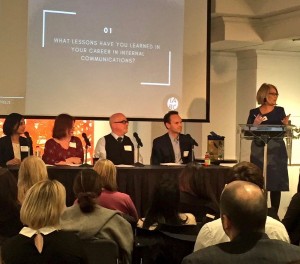 Whether your organization has five people or 50,000, there is no “silver bullet” that will solve all your communication challenges. And despite the shiny toys of the digital age, panelists at an IABC event on Feb. 28 agreed that old-school listening, talking to employees and face-to-face communication are as important as ever.
Whether your organization has five people or 50,000, there is no “silver bullet” that will solve all your communication challenges. And despite the shiny toys of the digital age, panelists at an IABC event on Feb. 28 agreed that old-school listening, talking to employees and face-to-face communication are as important as ever.
The session brought together Jackie Desouza, Director, Strategic Communications for the City of Toronto; Jason Jacobs, Director, Strategic & Online Communications for RBC; Mark Jordan, Director of Digital Projects, Brand Strategy & Communications at SickKids Foundation; and Sherrilynne Starkie, President, Thornley Fallis Communications.
With a combined 125 years or so of experience, panelists agreed you have to know your audience and how they interact with the communication channels you use. As Sherrilynne said, “Consult your internal audience early and often.”
Mark suggested looking to employees for ideas. “They’re saying, ‘Don’t tell me, involve me in what you’re creating’,” he said.
How do you reach employees?
“Multiple times through multiple channels,” Jackie said. “One-third of our employees are in the field, so we need to use a lot of channels to reach them.”
Traditional or tried-and-true tools the panelists use include:
- Email newsletters, to consolidate messages
- Email blasts
- “Cascade” briefings with managers, supervisors
- Engagement surveys
- Face-to-face meetings
- Intranet sites
- Job-site tailgate “parties” led by managers with tablets (Jackie: “Reach people where they are.”)
- Print notices and posters
- Social collaboration tools
- Town hall meetings and all-day summits
- Video
- Voice mail
What are the new tools?
- Collaborative tools like IBM’s InnovationJam, which Jason’s team used to reach 88,000 employees in 23,000 conversations over three days
- Content aggregation
- Customer relationship management tools
- Digital engagement tools – Sherrilynne’s team built their own Facebook-like tool called 76engage
- Infographics
- Mobile (Mark: “Anything we’re creating net new must be mobile.”)
- Online meeting and videoconferencing tools like WebEX
- Portals for managers/supervisors to strengthen their communication with employees
- Social media; include training, policies and support for sharing approved content
- Yet more video
Communication should be “relevant and useful,” Jason said, and constant measurement is key. He uses Newsweaver, which clearly shows that readership of written internal communications drops off after 300 words.
Internal communications must be aligned to business objectives, so find out if you’re “moving the needle” on big objectives, Sherrilynne said.
Mark agreed, “Understand your objectives and how they connect to what the company is trying to achieve.”
“Get feedback from managers and supervisors,” Jackie added.
Much has been made about communicating to millennials, but the panelists agreed that it should be less about specific tactics for one group and more about different ways to engage and benefit all employees.
In short: Build in newer tools to complement traditional tactics. Make it easy and quick. Be conversational and use plain language. Apply the concept of content marketing. Encourage discussion, listen to questions and use employee insights.
Photo: From left, Jackie Desouza, Sherrilynne Starkie, Mark Jordan and Jason Jacobs talk about internal communications in the digital age, moderated by Judy Mann, Director, Marketing & Communications, Healthcare for Ontario Pension Plan.
